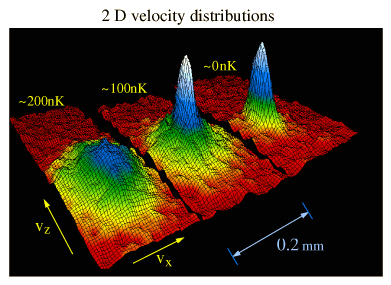Bose-Einstein Condensates with Rubidium Atoms
In 1924 Einstein pointed out that bosons could "condense" in unlimited numbers into a single ground state since they are governed by Bose-Einstein statistics and not constrained by the Pauli exclusion principle. This state of matter was called a Bose-Einstein condensate. In the intervening years there was little notice of this possibility except in the behavior of superfluid helium and in superconductivity.
The awarding of the 2001 Nobel Prize in Physics to Cornell, Ketterle, and Wieman for their investigations of Bose-Einstein condensates highlights the fact that they are now very active research subjects. Cornell and Wieman's part of the prize came from their studies of BEC in the alkali metal rubidium. The research group at the University of Colorado, Boulder was able to trap collections of around a million rubidium atoms in the condensed state with trap lifetimes up to 1000 seconds. With the condensate they were able to demonstrate collective excitations of the atoms. They demonstrated two-component condensates for the 1,1 and 2,2 spin states which persisted. One experiment demonstrated a vortex state for the BEC. They were able to demonstrate and image the "explosive" collapse of a BEC at a temperature of 200 nanoKelvins on a time scale of about 5 ms.

The JILA team was able to image the BEC as it was cooled from 200 nanoKelvin down to a reported temperature of 20 nK. The coherent BEC emerged as a peak representing a group of atoms with the same velocity, surrounded by a field of normal atoms with random velocities. The BEC represented about 2000 atoms of rubidium.
The Bose-Einstein condensates are made with ultra-cold, dilute gases. Their observation marks the culmination of a period of development of techniques for achieving very low temperatures and the confinement of atoms at those temperatures. The use of laser cooling and the trapping of ultra-cold atoms with magnetic traps has produced temperatures in the nanokelvin range. The JILA team reported that the laser cooling brought the temperature down to 10 microkelvin. Some 10 million atoms were trapped by the laser cooling and then held in a magnetic trap. They are held in place by a quadrupole magnetic field, but such a field has a "hole" in it that will allow the atoms to escape. The JILA researchers devised a way to rotate the "hole" at a rate that the atoms couldn't follow, effectively sealing the hole. The last stages of the cooling involve "evaporation" of the more energetic atoms from the magnetic trap, leaving behind a collection of atoms that is colder and more dense.
Reference
Cornell and Wieman
| HyperPhysics***** Quantum Physics ***** Particles | R Nave |